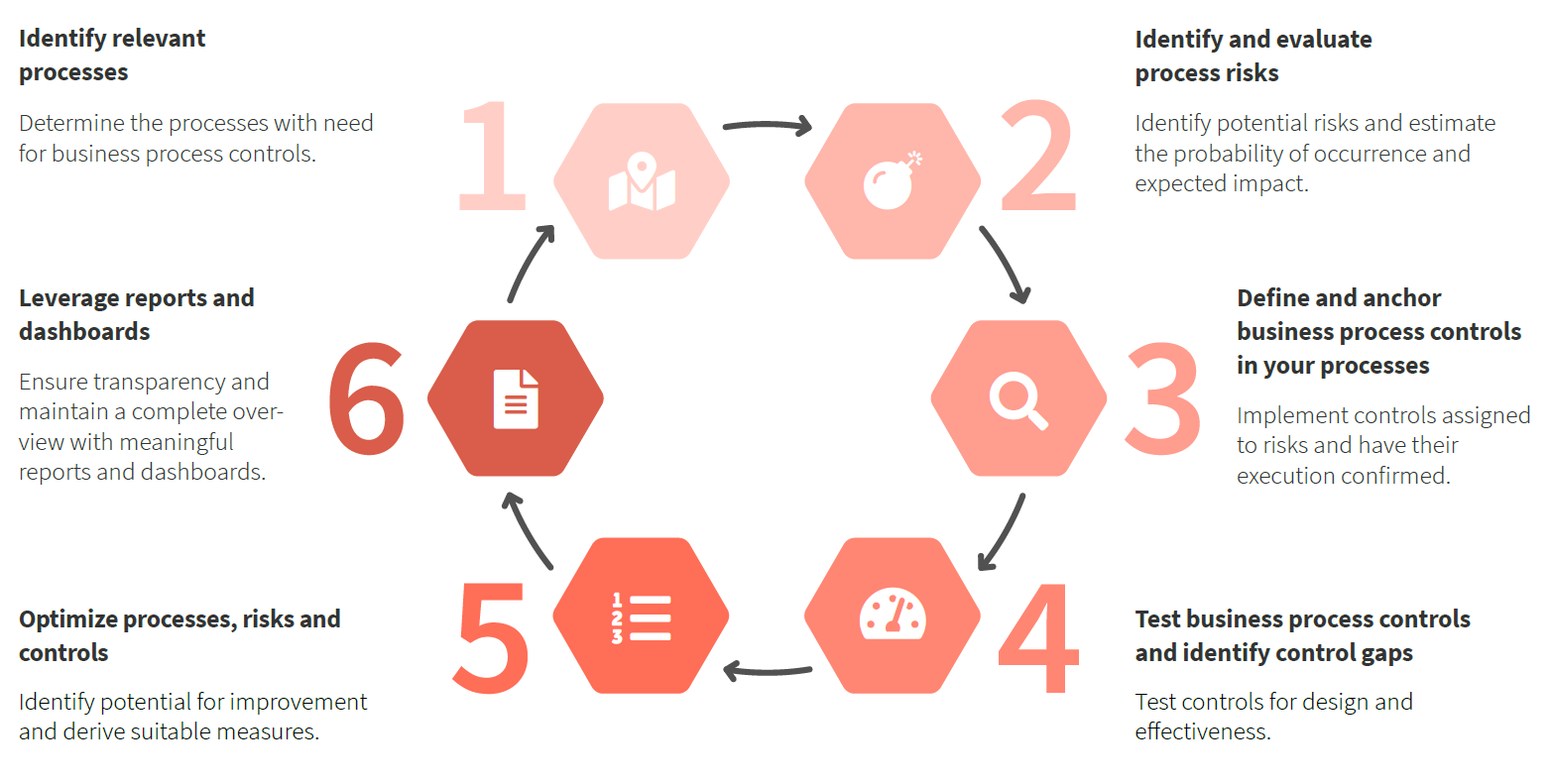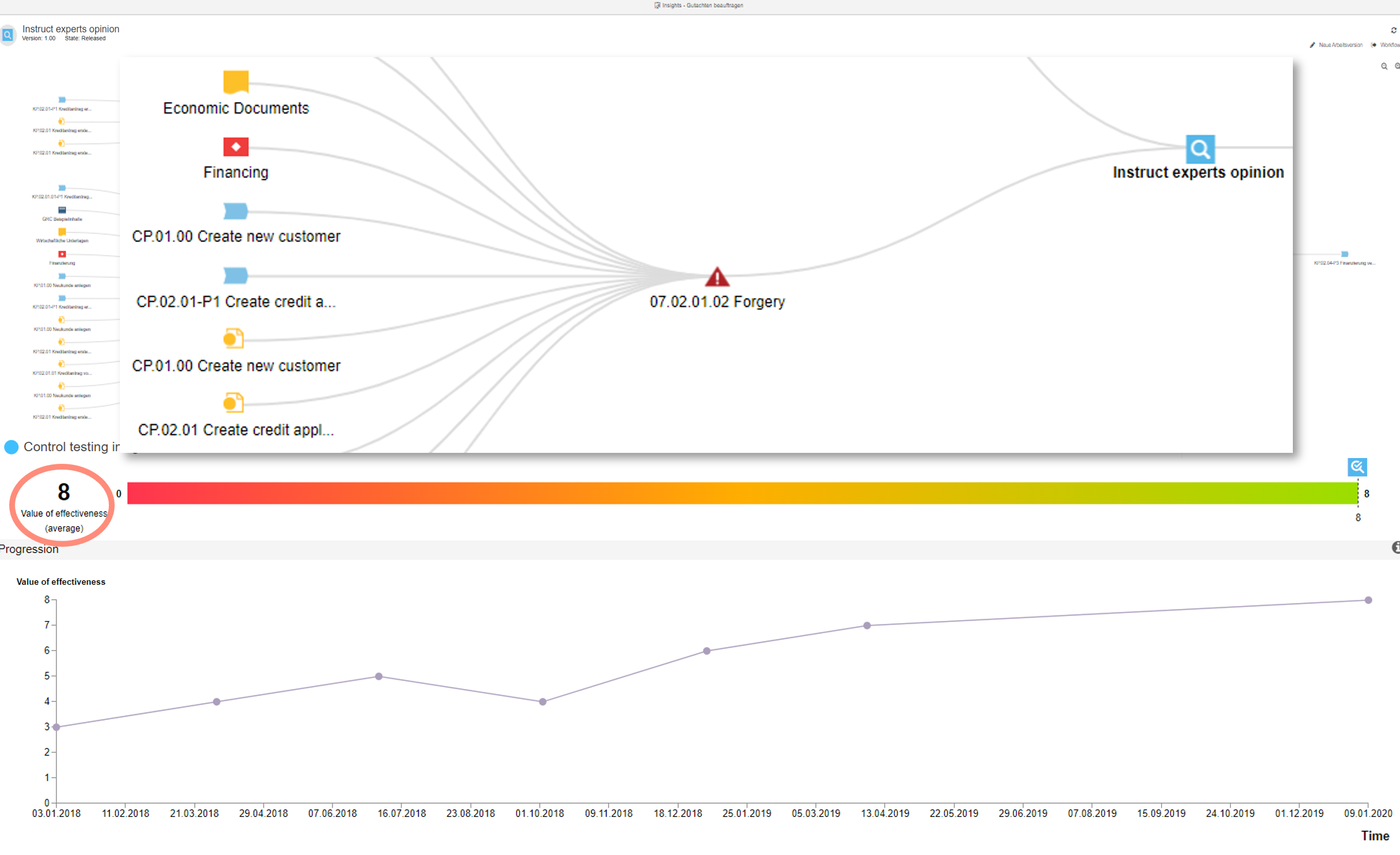Found this helpful? Share it with peers.
Introduction
Ensuring smooth process flows is a difficult undertaking for process owners. Especially because process steps are often not executed according to set instructions. This is where business process controls can be a great remedy and help you ensure efficient process execution.
Discover in this blog post the added value that business process controls could bring, how they relate to an Internal Control System, and learn about the 6 steps you can take to successfully integrate them into your process landscape.
Why business process controls are considered an integral part of processes
As a process owner, you are responsible for a whole variety of tasks. These range from planning and managing, to the continuous optimization of business processes within your organization. Your main interest is therefore to ensure that your defined processes work as specified.
In practice, however, this is often more difficult than it seems. Especially when it comes to ensuring smooth process flows, you are confronted with a number of challenges. These, as you may know, are typically tied to the deviations in operational execution of the individual process steps, i.e. the activities that are carried out by the employees. And this is exactly where business process controls come into play.
Business process controls are detailed tasks that help you to realize your processes effectively and efficiently. They guarantee that the performance or condition is always maintained at the same level. And as a process owner you can highly benefit from them in the following areas:
- meeting compliance requirements
- mitigating process risks
- saving time and costs
- keeping the set process quality standards
- achieving your process goals efficiently
In the next few paragraphs, we’ll share with you what it takes to successfully implement business process controls in your processes and how to realize their true potential. But before we go into this in more detail, we’d like to take a brief look at the internal control system (ICS) and explain why ICS is also of fundamental importance for you as a process owner.
Business process controls as part of an Internal Control System (ICS)
As a process owner, the term “internal control system” is probably not part of your daily vocabulary. So, you may have little or no awareness of it in the context of your environment. However, what you also may not know is how great of an advantage an ICS can be to you as a process owner.
In principle, these are simply internal (business process) controls that ensure the achievement of your defined goals and compliance with external requirements. In the following sections, when we go into the 6 steps in more detail, we’ll guide you through the introduction of an internal control system – that you can easily use for your individual process requirements.
How to implement business process controls in 6 easy steps
To ensure that the introduction of business process controls is successful and that they unfold their true benefit, we recommend that you follow the 6 steps shown in the figure below.
These will not only support you in the initial implementation of your process controls, but also help you review your existing control landscape.

Step 1: Identify relevant processes
Every company has a substantial number of processes. Thus, the probability’s also quite high that there’s a need for improvement in one or the other process. But, it’s important that you don’t go and optimize all of your processes at the same time, rather start with individual business processes first. Focus is the key term here!
First, identify and prioritize particularly important business processes. Start with your core and support processes, for example from IT or accounting departments. Indicators for processes with an urgent need for business process controls include the following:
- complexity of processes
- number of process executions,
- number of registered loss events or
- number of complaints received
Step 2: Identify and evaluate process risks
Once you’ve identified processes that require improvement, the next step is to determine and assess potential risks within your processes. This is because only the identification of risk sources and risk drivers enables the planning of control steps at the appropriate point.
So after you’ve detected potential process risks, you move on to assessing them. Evaluate your risks according to their probability of occurrence and expected impact at periodic intervals. In doing so, make sure to adapt the assessment process to your specific business requirements.
Step 3: Define and anchor business process controls in your processes
Once the basic groundwork consisting of the first two steps is done, you can now fully concentrate on anchoring your business process controls.
To do so, first define the control steps within your process models (see the graphic above). The description of the business process control includes, among other things, the type of control, frequency, responsibilities, technical resources used, and applicable documents.
When it comes to the frequency and intensity of the control, it’s important to emphasize that this should be adapted to the requirements of individual process. On one hand, this allows the risk to be limited as far as possible and, on the other, prevents the process from becoming cumbersome due to too many control measures.
To ensure effective process execution, we also recommend having the execution of business process controls confirmed at periodic intervals. This can be done, for example, in the form of protocols, e-mails or as confirmation in a system. In this way, you can track and also prove the correct execution of your business process controls at any time. This is particularly useful for audits by internal revision or external certification authorities.
Step 4: Test business process controls and identify control gaps
In addition to the specification of business process controls, it’s also essential that you regularly test them for appropriateness and effectiveness. As part of the so-called control tests, you analyse whether the control evidence has been provided in the period under review and whether you have achieved your defined process objectives. This enables you to quickly uncover control gaps and identify potentials for improvement. You should also document the results of the control tests and any other considerations.

Step 5: Optimize business processes, risks and business process controls
If you’ve discovered room for improvement, for example through control tests or with regards to your risks, you can optimize your processes with the help of concrete measures. Measures are characterized foremost by their project character and differ significantly from controls in this respect. In most cases, measures are planned, implemented and completed once. At this point, we recommend involving both the affected persons and the audit in the optimization process.
Step 6: Leverage reports and dashboards
Use reports and dashboards for your specific requirements. In addition to increased transparency, you also benefit from a holistic view of upcoming tasks for all roles involved in the process.
The process documentation as the basis for business process controls
The basis for the introduction of business process controls is, of course, detailed process documentation. This starts at the process landscape level and usually ends with a detailed description of all work steps at the operational level.
Therefore, if you have not yet created any process documentation yet, we strongly recommend starting with that as a very first step. You can read all important information on this topic in our business process documentation guide.
A business process management software, like the renowned BPM suite ADONIS, can provide great support in this endeavor. Advantages range from simple and standardized documentation of processes, process clarity and transparency, to the increase in quality that comes with it. For these reasons and more, companies increasingly turn to BPM software for their manifold added-benefits.
So, if you’ve already documented your processes with tool support, your first big milestone is covered. This makes it all the easier to build on this foundation and implement your business process controls using an ICS software. Just kick off with step 1 directly (Identify relevant business processes) and make sure your processes operate seamlessly.

Summary
As you can see, business process controls (i.e., an internal control system) are an incredibly helpful asset for process owners. They support you in achieving your process goals, adhering to compliance requirements, managing process risks and accelerating your business processes. Further advantages include easy sourcing of recommendations for improvement, as well as the integrated view of processes, risks, controls, measures and much more.
In our free poster you will find a compact overview of the 6 steps and all essential information at a glance. What’s more, we’ve included some of our key tips and best practices to help you get even more out of your processes!
Of course, if you’d like to discuss your individual use case, one of our process experts will gladly answer all your questions. Simply fill out our contact form below and we will get back to you shortly!





